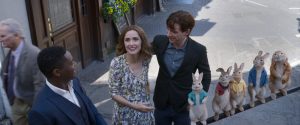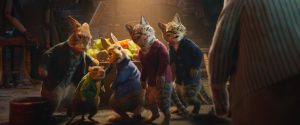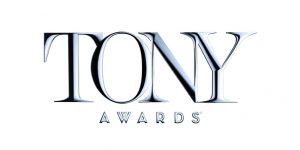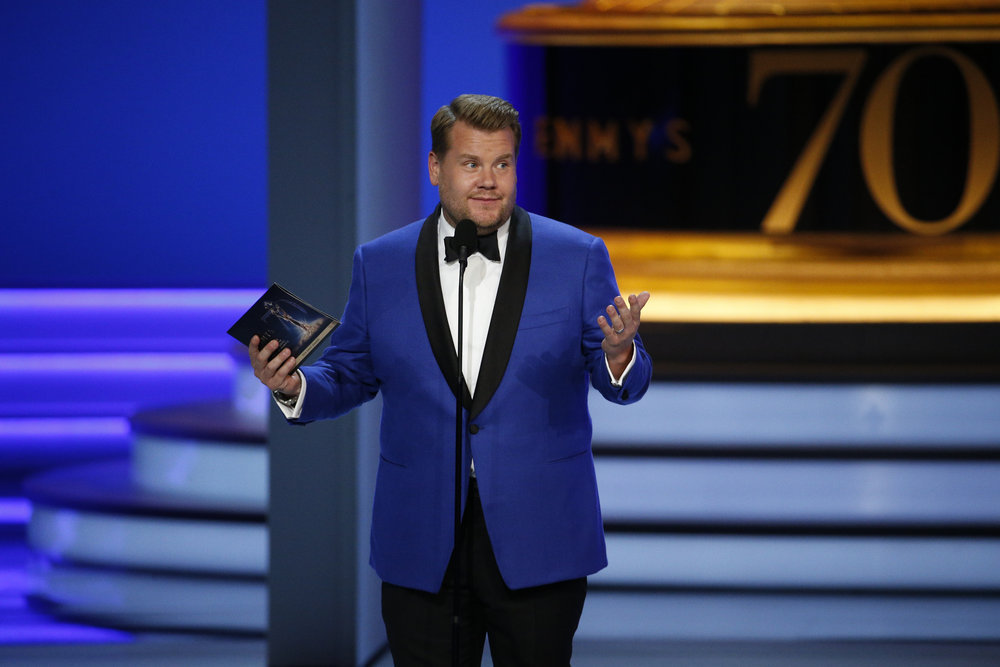September 26, 2021
by Carla Hay

Directed by Oren Jacoby
Culture Representation: The documentary “On Broadway” features a nearly all-white group of people (with one African American, one mixed-race person and one Asian) discussing the history of Broadway theater productions, from the 1950s to the 2010s.
Culture Clash: Broadway has weathered its share of ups and downs, including theater shutdowns due to the COVID-19 pandemic and ibeing in crime-ridden areas; the AIDS crisis devastating the Broadway community; and criticism that Broadway shows are too elitist and too expensive.
Culture Audience: “On Broadway” will appeal primarily to people who are interested in a documentary that presents a very optimistic view of Broadway without delving too deeply into controversial subject matter.

“On Broadway” is everything that you might expect a documentary to be that celebrates the history of Broadway shows from the 1950s to the 2010s. Expect to hear stories about Broadway’s highs and lows, but don’t expect to hear anything too scandalous. Directed by Oren Jacoby (an Oscar-nominated documentarian), “On Broadway” probably won’t be revealing enough for people who are Broadway trivia fanatics. This documentary is for people who want to see a selective history of Broadway, presented like a love letter instead of a scathing exposé of the dark sides of the business.
It’s a traditionally made documentary that mixes archival footage with exclusive documentary interviews. It looks like some of these interviews happened about 10 to 15 years before this 2021 documentary was released, while other interviews took place in or close to 2018/early 2019, when this documentary was completed. And a few of the people who were interviewed for the film have since passed away. For example, the documentary has exclusive interviews with celebrated playwright August Wilson (who died in 2005, at the age of 60) and Broadway producer/director extraordinaire Hal Prince, who died in 2019, at the age of 91.
“On Broadway” had its world premiere at the 2019 DOC NYC film festival, so this movie does not include any extensive coverage of the COVID-19 pandemic’s impact on Broadway, when theaters were shut down from March 2020 to August 2021. However, the movie’s epilogue does have a brief mention of the pandemic shutdowns and New York City’s long-delayed plans to re-open Broadway theaters in September 2021. It fits the tone and messaging of the rest of the documentary: Broadway, also known as Great White Way, is also the Great Comeback Kid.
“On Broadway” begins with testimonials from actors and other creators who’ve made their marks on Broadway, which consists of a cluster of designated theaters in New York City’s midtown Manhattan. Tony-winning actress Helen Mirren (“The Audience”) says that the first time that she went to New York City to rehearse for her Broadway debut (a 1994 production of “A Month in the Country”), she remembers looking at the Manhattan skyline and thinking: “‘Will I conquer New York? Will I survive it, even?’ The whole concept of Broadway has this very romantic, very heroic, very legendary kind of feel to it.”
Alec Baldwin (who earned a Tony nomination for his portrayal of Stanley Kowalski in the 1992 Broadway production of “A Streetcar Named Desire”) has this to say about Broadway: “New York is a place that when 8 o’clock at night rolls around, the curtain is opening on some of the greatest performances around the world, in one city. It is almost incomprehensible the amount of talent that is on display at that one moment.”
Tony-winning actor Hugh Jackman (“The Boy From Oz”), who has also won an Emmy Award for hosting the 2005 Tony Awards ceremony, comments: “As a performer, Broadway is different from anywhere else on the planet. You feel the audience are leaning in, they’re wanting to have a great time, they’re ready to enjoy it. It’s the most palpable I’ve ever felt—that connection with an audience.”
The documentary includes the expected footage and commentary about how influential Broadway is to actors and actresses. Tony-winning actress Christine Baranski (“The Real Thing,” “Rumors”) says with great fondness: “‘Company’ was the first musical I saw on Broadway. And I just thought, ‘Okay, this is the New York theater!” The documentary has brief archival clips of several stars who starred in Broadway shows before they became famous for their work in movies, such as Lithgow, McKellen, Mirren, Viola Davis and Courtney B. Vance.
Tony-winning director George C. Wolfe (“Angels in America: Millennium Approaches” and “Bring in ‘da Noise/Bring in ‘da Funk”) says that Broadway is more than just a bunch of buildings. “Something that ends up resonating with people ends up inhabiting those buildings. And it creates a kind of strange, odd, wonderful energy.”
Wolfe continues, “And all of a sudden, those buildings become kind of a church that attracts these devotees who become empowered by what’s on that stage. But at the same time, it’s a commercial landscape. And every day, you have to pay your rent. That’s the key to Broadway.”
The debate over art versus commerce certainly applies to Broadway, which is a tough business for a production to make a profit. Most Broadway productions end up being money-losing investments. The Broadway shows that run for years are the ones that are like winning the lottery.
In addition to having a narrative history of Broadway, the documentary includes an all-access profile of “The Nap,” a British imported play about snooker players that debuted on Broadway during the 2018-2019 season. “The Nap” (which had a limited run from September to November 2018) was considered financially riskier than a typical Broadway show, since it didn’t have any big-name stars and because snooker is a game that’s largely unfamiliar to American audiences. “On Broadway” followed the Broadway production of “The Nap” from its rehearsals to opening night.
The documentary includes interviews with “The Nap” playwright Richard Bean, “The Nap” Broadway director Daniel Sullivan and “The Nap” co-star Alexandra Billings, who made her Broadway debut in the show. As one of the first transgender actors to portray a transgender character on Broadway, Billings expresses gratitude and amazement at how far she’s come in overcoming personal setbacks (including drug addiction and homelessness) to end up starring in a Broadway show. She says, “The Broadway journey: There’s so much history attached. We need to remember our history.”
“On Broadway” takes viewers through a chronological history of Broadway with an impressive array of archival footage and various commentaries from Broadway insiders. The 1950s through the mid-1960s are described as the Golden Age of Broadway. Business was booming, and Broadway shows often influenced pop culture in music and in movies.
However, by the late 1960s, with the counterculture movement becoming a major force in society, Broadway was considered old-fashioned and out-of-touch by many people. In addition, the streets of midtown Manhattan’s Times Square, where almost all Broadway theaters are located, became increasingly crime-infested. As a result, by the mid-1970s, many Broadway theaters were shut down, and Broadway experienced a major slump. New York City was also on the verge of declaring bankruptcy.
Tony-winning actor John Lithgow (“The Changing Room” and “The Sweet Smell of Success”) remembers, “The theater district in those days: You can’t believe how different it was. It was so down on its luck.” The documentary mentions that Broadway attendance dropped from 10 million people in 1969 to 4.8 million people in 1972.
However, during this economically depressed period of time for Broadway, new talent emerged that pushed Broadway to new levels of creativity. Musical composer Stephen Sondheim and the aforementioned groundbreaking producer/director Prince are named as the two luminaries who had the most influence on the new and original Broadway shows that emerged from the late 1960s through the 1970s.
Prince and Sondheim worked separately for most of ther projects. However, their collaborations included “Company” and “Pacific Overtures,” which are named as examples of Broadway musicals that were reactions to criticism that Broadway was outdated and playing it too safe. Plays and musicals began to include topics that were once considered taboo on Broadway, including war protests, the feminist movement, LGBTQ rights and abortion.
The documentary notes how the majority of the theaters were dominated by three theater owners in the 1970s: The Shubert Organization, the Nederlander Organization and Jujamcyn Theaters. Out of financial desperation, the Shubert family let attorneys Gerald Schoenfeld and Bernard B. Jacobs take over the Shubert Organization in 1972.
The leadership change at the Shubert Organization led to a rethinking of investment strategies, by doing something that was groundbreaking at the time: Giving more freedom to the artistic people in Broadway, such as allowing them to spend time workshopping a production instead of just rehearsing. Broadway icons such as director/choreographer Bob Fosse and choreographer Michael Bennett were among those who benefited from this strategy.
Nederlander Organization managing director Elizabeth McCann says of this period of time when Broadway was in an economic decline: “They were all desperate for product.” One of the first new productions that Shubert invested in was Fosse’s “Pippin,” because the company believed in him.
New York City’s slow but eventual clean-up of Times Square led to closures of strip clubs and porn theaters and the arrival of more family-friendly businesses. In 1995, the Walt Disney Company began leasing the New Amsterdam Theater in a deal that’s considered a game changer in Broadway. In collaboration with the 42nd Street Development Project, Disney agreed to renovate the theater, which re-opened in 1997. As part of the deal, the New Amsterdam Theater is the exclusive home of Broadway productions that are based on Disney intellectual property.
The documentary singles out several Broadway productions as groundbreaking in their own ways. In the 1970s, “A Chorus Line” broke Broadway box-office records at the time and was the first Broadway show to be owned by a nonprofit group: the Public Theater. “Ain’t Misbehavin'” broke racial barriers on Broadway for having African Americans as a majority of its cast. “Annie” broke the stereotype that a Broadway show needed a rave review from the New York Times to be a long-running hit. The smash hit “Nicholas Nickleby,” with its eight-hour running time, broke the conventional practice of limiting a Broadway show’s running time to two or three hours.
By the late 1970s, Broadway was in full comeback mode, aided by the “I Love New York” ad campaign that featured Broadway shows. Popular shows on Broadway, such as “Grease” and “The Wiz,” were made into movies. Broadway in the 1970s and the 1980s had a British invasion, led by composer/producer Andrew Lloyd Webber and producer Cameron Mackintosh. Separately and together, Webber and Mackintosh brought numerous hits to Broadway, such as their collaborations on “Cats” and “The Phantom of the Opera.” (The documentary includes brief clips of an interview with Mackintosh.) The 1980s also saw a rise of acclaimed Broadway plays by and about LGBTQ people, most notably Harvey Fierstein’s “Torch Song Trilogy.”
The 1990s ushered in a resurgence in Broadway’s popularity with young people, thanks largely to Jonathan Larson’s “Rent.” “Angels in America” (from playwright Tony Kushner) and “Rent” also brought frank depictions of the AIDS crisis into major storylines for Broadway shows. The 1990s was also the decade where the Disney-fication of Broadway began to take hold in the trend of turning movies into long-running Broadway musicals. The smash hit “The Lion King” was an obvious standout. Also in the 1990s, a Broadway trend began that isn’t going away anytime soon: jukebox musicals built around the hit songs of famous music artists. “Mamma Mia!,” based on ABBA songs, is considered the first blockbuster in this jukebox musical trend.
Even with several Broadway hits being churned out that are based on pre-existing entertainment, the phenomenal success of Lin-Manuel Miranda’s “Hamilton” proves that Broadway audiences are still hungry for completely original productions. In the documentary, “Hamilton” is credited with bringing more multiracial audiences than ever before to Broadway. “Hamilton’s” race-swapping of historical figures and incorporation of rap/hip-hop are also cited as groundbreaking for a Broadway show.
“On Broadway” wants to have such a relentlessly “cheerleader” attitude about the Broadway industry that it tends to ignore some uncomfortable topics, such as racism. Instead, the movie’s way of discussing Broadway’s race relations is to focus more on the accomplishments of Broadway’s prolific people of color (such as Wolfe, Wilson and Miranda) who were able to break racial barriers in the world of Broadway. Sexism and the #MeToo movement aren’t mentioned at all. The movie’s epilogue acts as if the abuse scandals that led to the 2021 downfall of Broadway mega-producer Scott Rudin just didn’t exist. The documentary gives no acknowledgement that Rudin’s fall from grace was big news that shook the Broadway industry.
Although the documentary does acknowledge the devastation that the AIDS crisis inflicted on the Broadway community, one of the movie’s flaws is that it could have had more coverage on what the Broadway community has done in response to the AIDS crisis. The documentary gives more screen time to Broadway people protesting and crying over the 1982 demolishment of the Morosco Theater, the Helen Hayes Theater and the Bijou (to make way for the Marriott Marquis in Times Square) than it gives to Broadway people doing something about the AIDS crisis. For example, “On Broadway” could have had a segment about the work of the nonprofit group Broadway Cares/Equity Fights AIDS. It’s a glaring omission.
Although “On Broadway” overlooks several social justice issues that directly impact Broadway, the documentary gives some recognition to the fact that Broadway gets a lot of criticism for being overpriced and elitist. At the same time, Broadway has also gotten backlash from the other end of the spectrum: Some people think that Broadway is catering too much to unsophisticated audiences, by relying heavily on movie adaptations and jukebox musicals for new Broadway shows.
Broadway producer Robert Fox comments on overpriced Broadway tickets: “I find gouging people unappealing. And I think people are being gouged. The amounts of money that people ar being asked to see things are insane. But it’s not called ‘show charity.’ It’s called ‘show business.'”
“The Nap” Broadway director Sullivan says that the high cost of putting on a Broadway show and the high risk of the show being a money-losing failure are aspects of the business that won’t change anytime soon: “Paying the kind of money you have to pay to put anything on a Broadway stage is almost foolhardy. But the excitement can’t be about the money. The excitement is about finding fascinating new work and taking that chance of putting it before the public.”
While “old school” Broadway people might gripe about the increasing number of movie adaptations and jukebox musicals that end up on Broadway, the general consensus by people interviewed in the documentary is that these adapted Broadway shows won’t replace the need for original content. Tony-winning actor James Corden (“One Man, Two Guvnors”) comments: “You’ve just always got to keep an eye on what’s new, what’s fresh, what’s going to inspire the next kid who thinks, ‘Oh my God. I’m going to write a play.'”
“On Broadway” includes interviews with people representing a cross-section of various jobs in Broadway—mostly people who are actors, producers, directors and theater officials. Among those interviewed are director/producer Lynne Meadow, director Jack O’Brien, the Public Theater artistic director Oskar Eustis, producer Manny Azenberg, director Nicholas Hytner, producer Sonia Friedman, producer Albert Poland and producer Nelle Nugent. Other people interviewed include playwright David Henry Hwang, theatrical ad agency director Nancy Coyne, city planner Carl Weisbrod, lighting designer Natasha Katz, former Jujamcyn Theaters president Rocco Landesman, The New 42nd Street founding president Cora Cahan, Sardi’s maître d’ Gianni Felidi, and theater journalists Michael Riedel, Jeremy Gerard and Michael Paulson.
Even though “On Broadway” glosses over many of the ongoing problems in the business of Broadway, the documentary is entertaining and can be informative to people who have limited or average knowledge of this great American platform of performing arts. Broadway has been written off as “dead” many times, but the message of the documentary is that when Broadway is in a rut, Broadway should not be underestimated to climb out of that rut to thrive once again.
Tony-winning actor/director/choreographer Tommy Tune sums up the resilience of Broadway by saying: “Broadway is like some old 42nd Street hooker. She just keeps plugging. And sometimes, she has new shoes on. And sometimes, she has old, broken-down shoes.”
Kino Lorber released “On Broadway” in select U.S. cinemas and in virtual cinemas on August 20, 2021. The movie’s release date on digital and DVD is on October 19, 2021.







